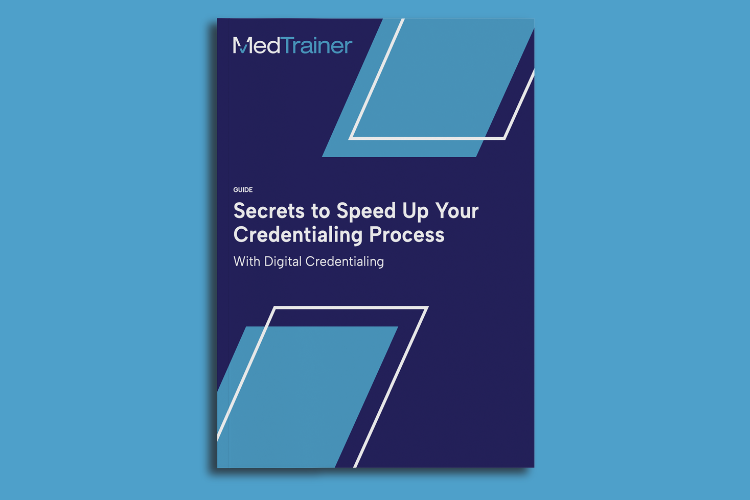When patients visit a healthcare facility, they want to make sure they’re being seen and treated by a qualified medical professional. Provider credentialing is a systematic process used by healthcare organizations to verify and evaluate the qualifications, competence, and professional background of healthcare providers. It involves collecting and reviewing information such as education, training, licensure, certifications, work history, malpractice history, and references — all in pursuit of verifying that providers are who they say they are and qualified to deliver legitimate, safe, and ethical care.
Listen to a candid discussion on lessons learned from the 2023 federal investigation that uncovered fraudulent medical practice nationwide in this on-demand webinar: Moving Forward From the Nursing Fraud Scheme.
By verifying the credentials of providers, healthcare organizations can establish a network of qualified professionals and maintain a high standard of care and patient safety. Here’s a closer look at provider credentialing: how it works, why it’s important, and how organizations can build strong processes around it.
How Does Provider Credentialing Work?
Provider credentialing involves verifying an individual’s education, training, licensure, certifications, work experience, and other relevant credentials. This multi-step process, also known as primary source verification, can take weeks and months to fully credential a provider.
Typically, the credentialing process starts as soon as a physician applies to work. The organization conducts a thorough review of their application and collects supporting documents, such as transcripts, licenses, and letters of recommendation. Primary source verification is done by contacting educational institutions, licensing boards, and other relevant authorities. The organization will also conduct background checks, including criminal record checks and verification of malpractice history.
Once all the information is gathered and verified — and if the medical professional is approved — they’re granted privileges to practice within the organization or network. After that, the credentialing process is periodically reviewed and renewed to ensure ongoing compliance with standards and regulations.
Why Is Provider Credentialing Important?
When you look at how much time, energy, and effort go into credentialing, it can seem like overkill. However, it’s important to remember how critical this process is for mitigating risk, improving compliance, and earning trust. A well-managed credentialing process opens the door to a host of benefits, including:
Patient Safety
Credentialing helps ensure the competence and qualifications of healthcare providers, which directly impacts patient safety. By verifying education, training, and experience, organizations help prevent unqualified or incompetent individuals from delivering care to patients.
Legal and Regulatory Compliance
Healthcare facilities and insurance companies are legally obligated to credential providers before allowing them to practice or join their networks. Compliance with these regulations helps protect the organization from legal and financial liabilities and demonstrates a commitment to patient safety and quality care.
Insurance Reimbursement
Insurance companies — along with government programs like Medicare and Medicaid — require providers to be credentialed to ensure they meet specific standards and qualifications. Without proper credentialing, providers may face difficulties in receiving reimbursement for their services, potentially impacting financial viability.
Provider Network Management
By thoroughly vetting and credentialing providers, organizations can ensure that their network consists of qualified professionals who meet the necessary standards. This helps attract patients, enhance the organization’s reputation, and ensure that patients have access to high-quality care within the network.
Credentialing touches every aspect of healthcare operations. Prioritizing strong, effectual provider credentialing sets a high bar for excellence for everything that follows.
The Problem With Traditional Credentialing
There’s no understating the importance of a thorough provider credentialing process. Unfortunately, because it’s so critical to get it right, credentialing often takes a very long time. Following up with each primary source can take weeks and there are often situations that require additional investigation, such as conflicting or missing information.
Thankfully, there’s an answer to modern-day credentialing that expedites the process without lowering the bar for quality: online credentialing software.
Cloud-based credentialing platforms organize, expedite, and simplify credentialing by intelligently automating much of the process. Instead of spending hours and hours playing phone tag or tracking down references, they can lean on software to help them confidently navigate the credentialing process with a single place for all provider data, documents, and communication. Moreover, software can speed up the credentialing process with proven workflow management for primary source verifications and payer enrollments. Even features like recredentialing reminders and highly-customizable reporting serve to make credentialing quicker and easier.
Get secrets to speed up your credentialing process.
How To Select a Provider Credentialing Service
If your organization is looking for a better way to approach provider credentialing, a cloud-based platform is a natural next step forward. But how do you know which one to choose? Selecting a credentialing provider takes a fair amount of due diligence; however, it’s time and energy that pay for themselves in short order.
Here are a few tips for selecting a provider credentialing service and what to keep in mind as you explore a credentialing platform:
1. Assess the Technology Used
In today’s digital healthcare environment, cloud-based services are the gold standard. Cloud technologies make it possible for you to see what’s happening and when, in real-time. Cloud accessibility also speeds up the credentialing process by giving everyone the access they need to upload documents, sign off on requests, and communicate efficiently. Ubiquitous accessibility — combined with cloud security that’s HIPAA compliant — sets the stage for faster credentialing.
2. Ensure State-Specific Experience
Every state has its own credentialing requirements. The platform you choose needs to be familiar with all states your providers work in and have the means to customize the credentialing process around those specifications. You also want your credentialing service to have established relationships with state-specific payers so they know who to call. This is an important consideration for large, established organizations and those that are growing.
3. Consider Value
Credentialing is vital to your organization’s revenue — so cost isn’t everything. Be sure to consider how much credentialing is truly costing your organization — in the form of time — without a service, or, one that is underperforming and/or inadequate. Perform a clear-cut cost-benefit analysis to make sure your investment in credentialing software helps you create different types of ROI beyond just bottom-line savings.
4. Choose a Partner
When the time comes to select software for provider credentialing, remember how important this relationship is. You’re partnering with this organization for one of the most important processes in your facility. Choose a platform you want to do business with for the long haul. Jumping from platform to platform will only obfuscate your credentialing efforts. Choose software that’s ready to support you over the long-term.
Consider MedTrainer Credentialing
Healthcare organizations big and small are entrusting MedTrainer with their provider credentialing because of the incredible efficiency they’re able to achieve. MedTrainer offers a team of credentialing specialists who are focused on specific regions, enabling organizations of all sizes to comply with state-specific regulations and ensuring peace of mind nationwide. Our experts handle various tasks including enrollments, primary source verifications, exclusions monitoring, document maintenance, recredentialing, and privileging, providing comprehensive support to numerous healthcare organizations.
With MedTrainer, you have complete visibility into every step of the process, allowing you to confidently generate reports for leadership. Additionally, we take care of recredentialing and continuous monitoring, to save you time and effort. Schedule a free demo today to see for yourself how easy Medtrainer makes credentialing — and how easy it is to reap the benefits.

